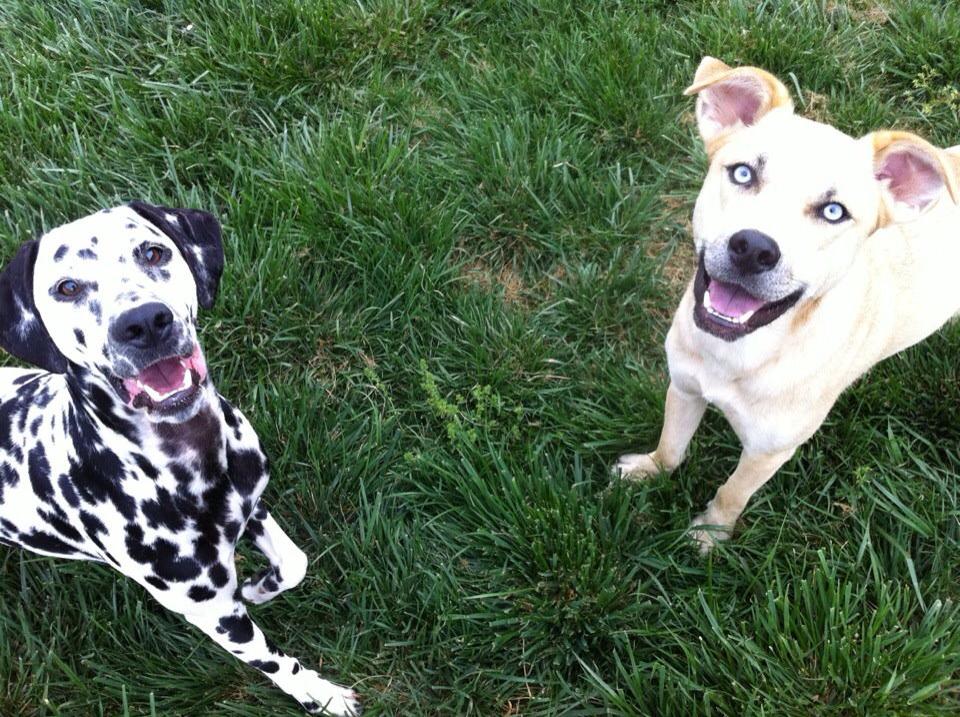Dr. Primm's Warm and Fuzzies
Thunderstorm Planning
by Kathryn Primm DVM on 12/20/13
If you dog is afraid of storms and loud noises, it is best to not wait until 3th of July to start to worry. There are things you can do now to plan for spring storms and summer fireworks.
In the winter or times of fewer storms, desensitize your dog to the sounds of a storm.
Play a CD of thunder recordings at low enough levels that don't frighten your dog, while giving him treats or playing a game. Gradually increase the volume over the course of several months, stopping if your dog shows any signs of anxiety. The goal is to get your dog used to the sound of thunder, and associate it with good things. Experts caution that desensitization can have limited success in an actual storm because you can only recreate the noise, and not the other factors that may be bothering the dog, such as the static electricity or changes in barometric pressure.
Give the dog a safe place where she can go in a storm and always.
That might be an open crate, a
basement where the dog can't hear or see what's happening outside, an interior
room with music playing, or a bathroom. Let your dog decide: Notice where he
goes during a storm, and if possible, allow access to it. Be sure your dog can
come and go freely, since some animals become more anxious if confined.Try offering a crate now when it is not stressful and making it a happy and safe place.
Reward calm behavior all the time.
Many owners make the mistake of trying to console and pet a fearful dog that's whimpering or climbing on them, inadvertently rewarding the scared behavior. Practice SIT, STAY training. Teach your dog at times when there is no storm to sit and stay on command. Practice so much that your dog knows that you will be pleased if she is sitting and staying. If she feels anxious, she can depend on that training to be sure to get the correct response from you, so always reward calm behavior. Ignore anxious behavior as much as you can. During a storm, try distraction with a favorite toy or game. BUT only give the toy if she is calm.
Consider a snug garment and calming pheromone producing items.
Snug-fitting shirts and wraps especially designed to calm anxious dogs are worth a try. Thundershirts work well for some dogs. At Applebrook, we see about 50% of dogs do calm down in the Thundershirt and sometimes using in conjunction with medications and Adaptil collar produces the most reliable improvement.
Be Patient.This type of anxiety is very difficult and frustrating. We will have to work together on this journey as we try different things. Hopefully we can discontinue the medication eventually or at least only give it during the summer.
Who Do I Think I Am?
by Kathryn Primm DVM on 11/19/13
I love to think and ponder things- random things and sometimes meaningful things. I have tried to explore where my family came from, who they were and what impact did they have on the world. I find genealogy interesting, especially when it has a personal touch like the TV show "Who Do You Think You Are?" So I hit ancestry.com with my typical mission based attitude. I found out a lot of things, but I guess the most interesting thing this time of year is that my 9th great grandfather was aboard the Mayflower. His name was John Alden (of the Miles Standish love triangle scandal, no less!)
Not long after my discovery, I got to visit Plymouth Plantation and see the replica of what the homes might have looked like and think about how the colonists lived. I got to read the plaques about what the people ate and what they wore and I got to speak with a man who was role playing as one of the pioneer men. He was dressed in era appropriate garb and he spoke with a believable accent. He told about the role that their animals played in their entire existence.
So then my overactive imagination conjured up images of these brave and pioneering people who faced so many obstacles, only for so many to be lost. They left their homes with their eyes on a better life for their family. Perhaps my mission based attitude is genetic from my pioneer ancestor, but nothing that we experience today is like what they endured. They had to watch friends and family sicken and die. They struggled with things that we take for granted. They were forced to make friends with people so different from themselves that they were afraid. They knew hunger, thirst, disease and suffering, but they built this country that we call home.Today's generation would be hard pressed to accomplish what they did, I fear. I know I would. I feel cut off from the world when my smart phone battery is dead! I imagined their lives parallel to my own. They would surely think that I was an angel (or a demon) with my strange devices and my "magical" way of healing the sick, but I think that they would they see how important my job would be to their survival. They depended on their animals. The role playing pioneer actor emphasized the importance of their animals in their daily lives. I told him I was a veterinarian and he looked at my quizzically. I tried to slip into character and went on to explain that I have a gift in caring for sick animals and then he smiled and we began to discuss the important role I would have in the colony and how glad he was that I was there.
The replica houses had live animals behind them and the man explained how they cared for and used the animals. Animals are as much a part of our history as the brave people are.
So were there animals at the first Thanksgiving? We do not know for sure, but we do know that without animals, there would not have been one.
I bought the cow....
by Kathryn Primm DVM on 11/07/13The saying goes "Why buy the cow when you can get the milk for free?" Now I know that this adage is not really about animals and we all know what it refers to, but there is another valid point in the saying.
4 Things Every Pet Owner Should Already Know
by Kathryn Primm DVM on 10/28/13
- Cats are not little dogs and no animal is a little person.
All animals are different, not just as individual personalities, but as species. Cats especially have a very unique metabolism. Medications that are ok for dogs can certainly kill a cat. An example of one such product is Advantix for dogs. It contains an ingredient that is highly toxic to cats and topical insecticides are one of the most common toxicities reported to animal poison controls. Animals are not just tiny people either. They are similar to us in many ways (and these ways amaze me every day), but if they were exactly like humans, there would be no need for different medical schools because one type of doctor could see us all! Human medications are a very large overdose for most pets because even the smallest human is larger than many of my patients. So the widely believed notion that Children' s Benadryl will help pets just like it does people is not really fact. In fact, although Benadryl is fairly safe for pets, it is not extremely effective for all the uses that I hear it given for. You can typically expect it to make pets sleepy though and sometimes that is enough to convince people that it is helping. In conclusion, just ask before you give human medications to pets.
- Chocolate is toxic to pets.
I have treated many cases of chocolate ingestion in dogs. Fortunately cats are thought to lack the ability to taste sweet so they seldom eat chocolate. Even small amounts of chocolate can cause vomiting and hyperactivity. Milk chocolate and white chocolate are the least dangerous, then dark chocolate and then baker's chocolate which contains the highest theobromine levels. It seems that every Easter and Halloween as bags and baskets of candy sit on countertops everywhere, I inevitably see a large volume of colorful, chocolate scented vomit. I remember specifically a little Westie I saw that we had to induce vomiting. She had not had the chocolate in her stomach long since her owner caught her "in the act", so when we induced vomiting, she produced melted chocolate with pale pink and yellow stripes in it. It smelled of chocolate and peanut butter. It took us a little while to feel the same about Reese's cups and M & Ms. Chocolate contains two different components that are toxic to dogs, theobromine and caffeine. The caffeine itself can cause tremors, tachycardia (increased heart rate), arrythmias, and potentially serious cardiovascular side effects, but theobromine is toxic outright. Serious reactions can occur with ingestion of about 100 to 150 milligrams of theobromine per kilogram of body weight. Even doses not as high as this require medical treatment, since we do not know how severely each individual can react. Thankfully most people notice the missing candy and suspect the guilty canine and are able to call me quickly. I have never lost a patient to chocolate ingestion...yet! If your dog eats chocolate, please call your vet and let them help you decide how much of an emergency you have. It is absolutely best to see the vet before the chocolate has time to digest and cause toxic effects. The best rule of thumb is never to assume your dog cannot reach something. I have had patients that climbed the backs of chairs to leap to countertops and then pull things off high shelves. They watch us all the time, soundlessly observing. They know that we are eating and they smell that it is something good. They watch where we set it and return to the spot when they are bored or hungry. Never underestimate a motivated canine!
- Tylenol will kill your cat.
Another aspect unique to cats is that acetaminophen is highly toxic in this species. We think of Tylenol as a super safe drug. I even took it when I was pregnant. Humans can metabolize it easily, but cats cannot. It will kill a cat and it is not an easy way to go either.
- There is no silver bullet.
My mother always said, "If it sounds too good to be true, it probably is." Her words are full of wisdom! I get occasional queries regarding things that clients have found on the internet with big claims of impacting and sometimes even curing disease. I research each one, because I too would love to find a miracle cure for anything that I am currently unable to "kick to the curb for good". Sadly, my mom is right. If your vet (or even your own MD) hasn't told you about something that is a miracle cure, it is probably not because he or she was unaware of it. Trust me, big news comes down the medical pipeline in a BIG hurry and most doctors make it their business to know all the latest things. I WANT to cure my patients of allergies and arthritis in the worst way. I know that it is frustrating to have or see something that can't be done away with for good. So, there is probably not an herbal supplement that will cure allergies. It is unlikely that a plant extract will fix arthritis, but since I am here and I am ready to listen and help you, tell me what you have found. Odds are that it is not a magic bullet, but it might have a place in your pet's medical protocol with reasonable expectations. I can help you know what to expect and decide how you could best spend your hard-earned money. We can get the biggest bang for the buck if we work together!
Fall Newsletter-new format
by Kathryn Primm DVM on 10/22/13
The fall newsletter is "on the presses" for delivery to your in-boxes on Friday. I am including a photo each time of a patient. We make them all the time, but if you have one that is especially endearing of your Applebrook pet, email it to us at staff@applebrookanimal.com and we will put it in line for the newsletter! Happy Fall, ya'll!







